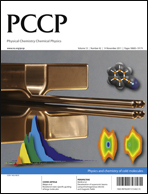Lifetime of vibrational levels from Fourier grid calculations: RbCs example
Abstract
We present systematic calculations of the lifetimes of vibrational levels of excited Rb(5s)Cs(6p1/2) 0+ electronic states. We show that a precise description of the variation with the internuclear distance of the transition dipole moment between electronic states is essential. It is also crucial to account precisely for the spin–orbit coupling between the Rb(5s)Cs(6p) A 1Σ+ and b 3Π states. We describe the general trends of the probability of formation of stable molecules in the Rb(5s)Cs(6s) X 1Σ+ and a 3Σ+ electronic states, through radiative decay from the 0+v′ levels, together with the branching ratios for the obtention of singlet or triplet molecules, stable with respect to dissociation. Furthermore, this analysis allows us to demonstrate the efficiency of the Mapped Fourier Grid Hamiltonian Representation method (MFGHR) to determine rigorously the energy variation, throughout the continuous part of the

- This article is part of the themed collection: Physics and chemistry of cold molecules

 Please wait while we load your content...
Please wait while we load your content...